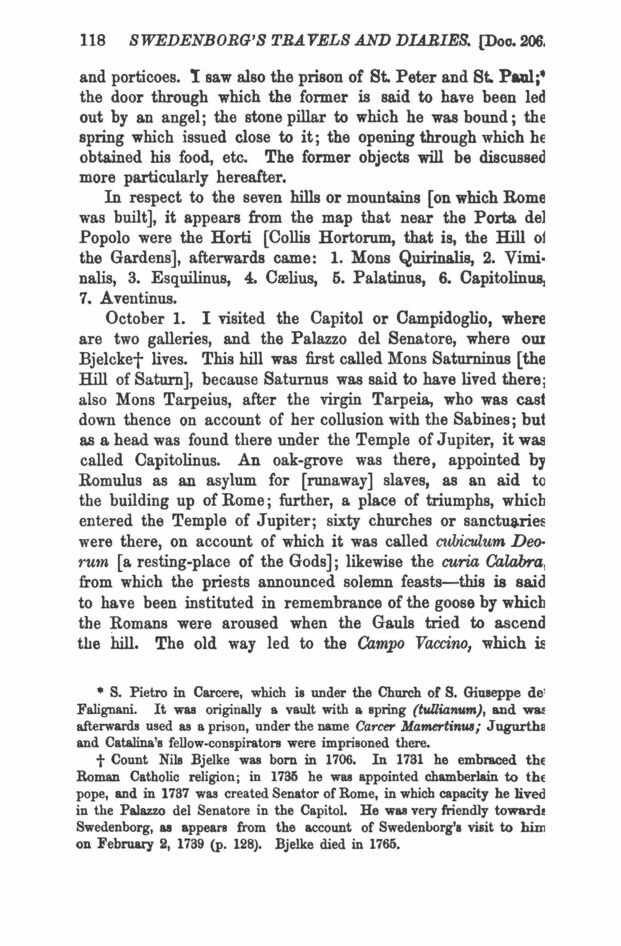
Full resolution (JPEG) - On this page / på denna sida - Sidor ...

<< prev. page << föreg. sida << >> nästa sida >> next page >>
Below is the raw OCR text
from the above scanned image.
Do you see an error? Proofread the page now!
Här nedan syns maskintolkade texten från faksimilbilden ovan.
Ser du något fel? Korrekturläs sidan nu!
This page has never been proofread. / Denna sida har aldrig korrekturlästs.
118 SWEDENBORG’S TRAVELS AND DIARIES. [Doc. 206.
and porticoes. I saw also the prison of St. Peter and St. Paul;*
the door through which the former is said to have been led
out by an angel ; the stone pillar to which he was bound ; the
spring which issued close to it ; the opening through which he
obtained his food, etc. The former objects will be discussed
more particularly hereafter.
In respect to the seven hills or mountains [on which Rome
was built], it appears from the map that near the Porta del
Popolo were the Horti [Collis Hortorum, that is, the Hill of
the Gardens], afterwards came : 1. Mons Quirinalis, 2. Vimi
nalis, 3. Esquilinus, 4. Cælius, 5. Palatinus, 6. Capitolinus,
7. Aventinus.
October 1. I visited the Capitol or Campidoglio, where
are two galleries, and the Palazzo del Senatore, where our
Bjelcket lives. This hill was first called Mons Saturninus [the
Hill of Saturn], because Saturnus was said to have lived there;
also Mons Tarpeius, after the virgin Tarpeia, who was cast
down thence on account of her collusion with the Sabines ; but
as a head was found there under the Temple of Jupiter, it was
called Capitolinus. An oak-grove was there , appointed by
Romulus as an asylum for [runaway] slaves, as an aid to
the building up of Rome; further, a place of triumphs, which
entered the Temple of Jupiter ; sixty churches or sanctuaries
were there, on account of which it was called cubiculum Deo
rum [a resting-place of the Gods] ; likewise the curia Calabra,
from which the priests announced solemn feasts-this is said
to have been instituted in remembrance of the goose by which
the Romans were aroused when the Gauls tried to ascend
the hill. The old way led to the Campo Vaccino, which is
* S. Pietro in Carcere, which is under the Church of S. Giuseppe de’
Falignani. It was originally a vault with a spring (tullianum), and was
afterwards used as a prison, under the name Carcer Mamertinus; Jugurtha
and Catalina’s fellow-conspirators were imprisoned there.
+ Count Nils Bjelke was born in 1706. In 1731 he embraced the
Roman Catholic religion ; in 1735 he was appointed chamberlain to the
pope, and in 1737 was created Senator of Rome, in which capacity he lived
in the Palazzo del Senatore in the Capitol. He was very friendly towards
Swedenborg, as appears from the account of Swedenborg’s visit to him
on February 2, 1739 (p. 128). Bjelke died in 1765.
<< prev. page << föreg. sida << >> nästa sida >> next page >>